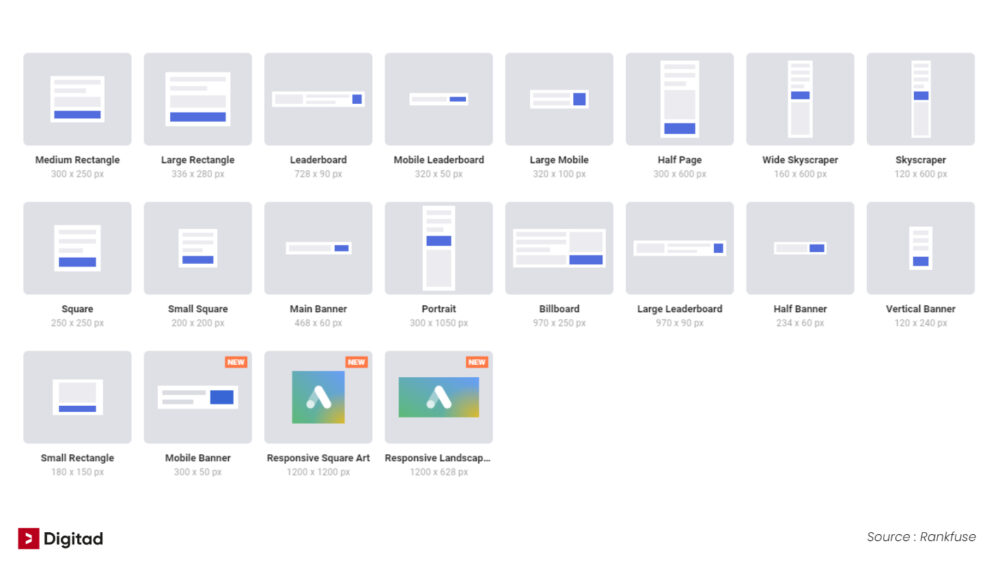Home Expertises Display / Prog
Maximize your advertising budget’s impact with performance-based online marketing

Social Media Advertising and Search Engine Marketing both target users on specific platforms, for example, Facebook or Google. But… your prospects use plenty of other websites on a daily basis!
That’s where Display and Programmatic advertising comes into play and lets you target these users, wherever they are on the Internet and in the World. It delivers the most accurate targeting opportunities in the industry through a wide range of demographic, behavioral, and contextual criteria.
Programmatic advertising and the Google Display Network are both tools used to buy advertising space online (mainly banners) through a bidding system, in order to reach a specific target audience.
Although they have much in common, programmatic and display campaigns have distinguishing characteristics.
Display advertising is a marketing technique that benefits both website owners and advertisers. Website owners can sell advertising space to monetize their traffic.
Display ads are commonly presented as advertising banners and are often situated in specific areas of website pages (such as the top, bottom, or right side of the page). Digital advertising observed outdoors on all sorts of screens has a different name: DOOH (Digital Out Of Home).
The most successful display advertising campaigns use a combination of images, text, gifs, and videos to stand out and reach their target audience.

Ads are distributed by the Google Display Network. The network helps advertisers find the right target audience and distribute their ads at the right place and at the right time throughout the customer journey.
With the display network, you can reach new prospective customers through the “similar segments” tool, which targets users who share characteristics with your existing customers. The network can also determine what are your most promising audiences and maximize your conversion rate with automated targeting.
Google uses two pricing models: CPC (cost per click) and CPM (cost per mille (mille = 1 thousand views)). Every time a user clicks on your ad, you pay a specific amount based on your bidding strategies.
According to certified experts at our Display ads agency, there are four key benefits to incorporating display advertising into your overall digital marketing strategy.
Programmatic advertising is usually defined as the automated buying and selling of online ad space, as opposed to traditional advertising which is bought and sold manually. But in fact, there is more to it!
Online advertising space is sold through Ad Exchanges, which are essentially digital marketplaces. They organize computer-assisted real-time auctions and connect the two parties involved in the transaction:
Programmatic advertising brings the whole process to the next level thanks to the computer algorithm that manages transactions and ad placement in a fraction of a second.
There are three types of programmatic media purchases:

Here is the process to purchase programmatic advertising space:
Despite its many steps, the whole process unfolds in an instant! And the algorithm has to calculate all competing offers and conduct a number of analyses to automatically determine the most profitable offer.
For example, if the user who clicked on the website looks qualified for your ad (based on their browsing history and online profile), your chances of winning the impression are higher.
By working with our display and programmatic ads agency on their advertising strategy, our clients found answers to the following questions:
By working with Digitad on your display and programmatic advertising strategy, you will benefit from a Digital Marketing Agency in Montreal that:
Will analyze your company and your market to build a profitable strategy fully aligned with your target audience and your offerings.

Will take care of your advertising using a proven work method, adapted to your specific needs by our certified display and programmatic ads agency experts.

Will guarantee transparency in all circumstances. Our digital display advertising agency in Montreal gives you full access to its management tool, so you can follow our progress.

Will be receptive and available to answer any of your questions, help you achieve your business objectives, and better understand display and programmatic advertising.

Will make signing a contract optional. If you are not satisfied with the results, you are free to end your collaboration with Digitad. We will instantly return all your intellectual property to you.


Display ads are found in specific locations on website pages or social media: often at the top, bottom, or right side of the page. Simply put, display ads are advertising banners.
Here’s how it works: Websites monetize their traffic and sell advertising space to advertisers.
Programmatic advertising refers to the real-time selling and buying of advertising space, using software-assisted auctions rather than manual bids. This way, advertisers pay for impressions based on the value of the audience seeing their ad, rather than based on a fixed CPM for all impressions on a website.
The main difference is whether or not the advertising purchasing process is automated. With programmatic, the software automates the bidding, while with display, advertisers must bid manually.
There are several banner ad formats, but here are the three most common:
Leaderboard (728 x 90 pixels) – horizontal space on the top right side of the page
Medium rectangle (300 x 250 pixels) – squarish rectangle space on the right side of the page
Skyscraper (120 x 600 pixels) – vertical space on the right side of the page
Does it mean you should use these three? Perhaps. But even better: use unconventional banner formats and run A/B tests to see what works best for you and your audience.
Like always, it depends. We recommend running both types. First, you’ll get to A/B test and figure out what works best for you.
Second, a user who sees both versions of your banner is more likely to notice it. Imagine this: you scan through a page, see a static banner ad, and barely notice it. But still, your brain records it. Then, you run into that same banner, but now it moves. This breaks your expectation, you tell yourself “wait, this thing moves?”, and instantly pay attention to it.
Banner ads typically have a lower click-through rate than most other forms of digital advertising. This being said, display ads tend to be affordable and come with advanced targeting options. An experienced display advertising agency can therefore help you set up campaigns, continuously test and improve, and find an approach that brings you an excellent ROI.
The very purpose of programmatic advertising is to automate ad placement to maximize its impact and save you time.
However, you should not worry about your ads being placed on sites that could compromise your reputation. First, Google does its best to remove sites with harmful or inappropriate content from its Display Network. Second, there are tools for you to whitelist or blacklist certain websites or types of content.
Yes. You can target the following devices: desktops, laptops, mobile phones, tablets, and even smart TVs.
The user will be redirected to a landing page. Landing pages encourage users to take specific actions, for example, complete a purchase or subscribe to a newsletter. Moreover, the click and ensuing actions will be recorded in your campaign data which allows for precise campaign performance monitoring.
Display campaigns are generally considered to be an excellent option for building awareness. Visual formats are appropriate for branding and display ads can be distributed on a wide variety of websites and reach any audience.
Monthly ad spend: $500 - $2500
Monthly ad spend: $500 - $5000
Monthly ad spend: to be determined
Contact and informations
Monday-Thursday:
7.00h – 23.00h
Friday:
7.00h – 13.00h
Newsletter
Subscribe to our newsletter to stay up-to-date with our course offerings and the latest online trends!
We will be happy to answer you!